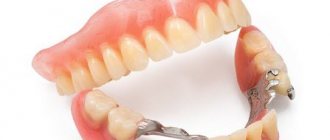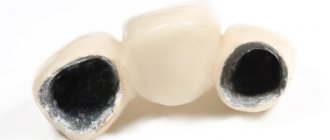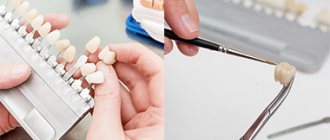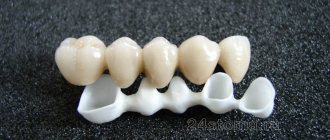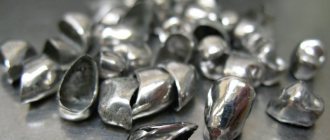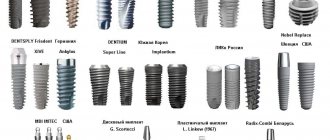We will describe in detail which crowns are best to place on chewing teeth and which on the front teeth. Our specialists have been installing the best crowns at affordable prices for over 25 years.
Many patients, before visiting a specialist, study the types of dental crowns and seek to find out which ones are best suited for each specific situation. Most people rely on forums, others ask their friends questions about the results of prosthetics. Unfortunately, only a few manage to obtain real information.
This article provides comprehensive information regarding the different types of crowns, methods of their manufacture, performance characteristics, service life and pricing policy. We hope that while reading this material you will study in detail the types of crowns on teeth and be able to understand which ones are best suited for a particular area of the jaw.
For everyone who does not know where it is best to put crowns on their teeth , we offer services of the highest level. In our clinic, all procedures are carried out under the guidance of specialists with impressive experience and deep knowledge in the field of prosthetics. In addition, we focus on using only modern durable materials, high-precision dental equipment, and implement effective technological solutions. This allows each patient to count on high-quality and long-lasting treatment results.
Types of Best Dental Crowns for 2022
Modern dentistry offers patients crowns made from various materials. It is this indicator that is key in determining the cost, quality parameters and indications for the use of a particular prosthesis. Another important criterion on which the quality of a product depends is the production method.
The following crowns are currently in demand:
- Metal-ceramic. They are among the most popular prosthetic devices. Includes a metal base and an outer facing layer of ceramics. Initially, the frame is made, after which the ceramic coating is performed. The production process can be carried out on the basis of modern computer programs and aesthetic modeling.
- All-ceramic. In the manufacture of such prostheses, metal-free ceramics are used. Provides maximum safety in relation to soft tissues, which is due to the biological inertness of this material. The manufacturing process is based on the firing technique; ceramic pressing technologies; use of milling equipment and modern digital programs.
- Crowns made of zirconium material. Despite its origin (metal), zirconium dioxide is famous for its unrivaled aesthetics and increased safety. The manufacturing process is based on the use of specialized digital programs and milling equipment. Two versions of such prostheses can be used: combined (include a base of zirconium material and ceramic lining) and monolithic (made of zirconium oxide without the use of a ceramic coating).
- Glass ceramics e.max. It is distinguished by perfect aesthetic parameters and the necessary strength. There are currently 2 material options in use: E.max RPESS - produced by injection molding using elevated pressure and temperature conditions, and E-max CAD - produced using modern digital applications and milling machines (CAD/CAM concept).
Comparative characteristics of the best crowns
To determine which crowns are the best , you need to study the pros and cons of each product, taking into account the material used.
Next, we will compare the key parameters of various prosthetic options:
| Crown | pros | Minuses |
| Made from metal-ceramics using precious metals | Has increased strength, has a natural appearance, does not cause allergization of the body | High price |
| Made from metal-ceramics using non-precious metals | It is famous for its sufficient strength, has a reasonable price and good aesthetic parameters | There is a possibility of allergy |
| Made of ceramic material | Features impeccable aesthetic parameters and absolute compatibility with the patient’s body | Increased fragility |
| Made of zirconium material | Excellent aesthetic properties, long period of operation, absolute compatibility with the body, absence of allergic reactions | Impressive value |
| e.max crowns | Unsurpassed aesthetics, increased strength, excellent light transmittance. Emax Press has a gradient of color and transparency. | High price. Only single crowns can be installed in the chewing region. |
Metal-ceramic prostheses.
What is a metal-ceramic prosthesis upon closer examination? First of all, it is a metal frame covered with a layer of hypoallergenic ceramics. If we compare modern metal-ceramic prostheses with their predecessors made of various composites, we will see the undoubted advantages of metal-ceramics:
- firstly, metal-ceramics reproduces the color and texture of natural tooth tissues quite well;
- secondly, it does not fade, does not absorb dyes and, therefore, does not change color over time;
- thirdly, dental ceramics used in dentures are hypoallergenic and do not cause rejection, except in rare cases;
- and finally, cermets are very durable.
If we are talking about removable dentures made of metal ceramics, then we are talking about a clasp denture. “Bugel” (clasp) means “arc”, and the prosthesis itself is precisely a metal arch with metal-ceramic crowns attached to it. Removable metal-ceramic structures are used when there are contraindications to installing a permanent metal-ceramic prosthesis.
What are the best crowns for chewing teeth?
In general, the controversial issue regarding which crown is best to place on chewing teeth may have a completely unambiguous solution. Since this department experiences increased chewing pressure, it is advisable to use high-strength and most reliable prostheses to recreate the missing units. However, despite the need to restore functional characteristics in this area, the aesthetic component should not be ignored. Moreover, making the right choice is also important from the standpoint of the biocompatibility of the material.
Next, you will get acquainted with detailed information regarding which crown is best to place on the chewing teeth, taking into account the material used:
- Metal ceramics . According to statistics, this material is among the most popular in orthopedic practice. First of all, this is due to the excellent quality and affordable prices for such crowns. As for the negative aspects, they include a significant likelihood of chipping, unlike traditional analogues. In addition, there is a risk of cyanosis appearing at the border of the gum and the prosthetic device, which has an undesirable effect on aesthetics;
- Dentures made of ceramic material . The possibility of using such crowns depends on their type. It is undesirable to fix standard ceramic structures in the masticatory region due to their significant fragility and increased likelihood of breakage. However, at the moment it has been possible to develop more durable crowns that make it possible to recreate the missing units in any area of the jaw. These include Emax and Empress glass-ceramic structures. But if you study dental crowns from the point of view of which ones are better, the price in this case is not a priority criterion (over 20,000 rubles per unit);
- Structures made of zirconium material . They allow you to recreate the missing units in the lateral section, since they are considered the most highly durable and durable prostheses. It is recommended to use monolithic crowns, which eliminates the possibility of using a porcelain coating and, as a result, minimizes the possibility of chipping. However, the price of such a prosthetic device can be higher than 30 thousand rubles;
- Emax crowns . Despite the exceptional aesthetics and excellent strength parameters (up to 400 MPa), such crowns are best used for the frontal area. For the chewing region, it is allowed to use single crowns made of E-max RPESS material obtained by pressing.
What is better: ceramics or metal-ceramics?
In answering this question, let’s try to understand the pros and cons of metal-ceramics and metal-free ceramics.
1. Metal-ceramic crowns
Metal-ceramic crowns are the most successful compromise today between strength, aesthetics and cost in dental prosthetics. Metal-ceramic crowns get their name due to the fact that they:
- have a cast metal frame inside (Fig. 1) - such a frame has a thickness of 0.3 - 0.5 mm. As a rule, it is made from cobalt-chromium or nickel-chromium alloys specially developed for dentistry. However, it is also possible to use alloys of precious metals consisting of gold, platinum, palladium, etc. in various proportions.
Hence, it is customary to distinguish between the types of metal-ceramic crowns: → metal-ceramics on a cobalt-chromium alloy (Fig. 2,3), → metal-ceramics on gold (Fig. 3), etc. The use of gold alloys has a big advantage, because... Due to the yellowness of the metal, it is possible to achieve a more natural shade of the crowns, which is especially important when replacing the front teeth.
- the metal frame is covered on top with ceramic mass - The frame is cladding in the form of layer-by-layer manual application of layers of ceramics. After applying each layer, the crown is fired in a special oven at a temperature of 800 - 950 degrees. It is with this technology of applying layers of ceramics and firing temperature that a strong chemical bond between ceramics and metal is achieved.
Advantages of metal-ceramic crowns
- Fairly acceptable aesthetics - if metal-ceramic crowns are made with high quality - they will largely match the appearance of your natural teeth. However, metal-ceramics will undoubtedly be inferior in aesthetics to crowns made of metal-free ceramics.
- Durability and strength – the cast metal frame ensures structural strength, and the ceramic veneer is not susceptible to caries or abrasion. Sometimes only small chips of the ceramic mass are possible, but this does not happen very often. In addition, it is possible to repair chipped ceramics directly in the oral cavity.
Disadvantages of metal-ceramic crowns
- The need to grind off a large volume of tooth tissue - this need is determined by the minimum thickness of the walls of the metal-ceramic crown. Grinding is usually carried out to a depth of 1.5-2 mm on all sides of the tooth.
Therefore, it is advisable: when restoring front teeth, give preference to veneers, when restoring chewing teeth, to give preference to restorative inlays. Unfortunately, there are not always conditions for this.
- The need to depulp teeth - in most cases - due to a large volume of grinding of hard tooth tissues creates conditions under which, during the grinding process, thermal burns of the dental pulp and its death are possible. Sometimes the death of the pulp and the development of inflammation do not develop immediately, but rather a long time after the crown has been fixed. This may require removal of the crown, re-treatment of the tooth, and accordingly leads to the need for re-prosthetics.
Therefore, in order to prevent thermal burns of the pulp, the tooth is depulped and the root canals are filled. Most often, it is possible to leave large molars alive, which have a large crown size and a large volume of hard tissue (enamel and dentin). Of course, if possible, it is necessary to leave the teeth under the crowns alive, because... In this case, teeth do not become as fragile as pulpless ones, and accordingly they can last longer.
Problem areas with metal-ceramic prosthetics:
- Blueness of the marginal gum - in most cases, immediately after prosthetics or in the distant future, you can notice the appearance of cyanosis of the gingival margin in the area of the crowns (Fig. 4). This is due to the presence of a metal frame. If you smile widely (your gums are clearly visible when you smile), then the cyanosis may be noticeable.
- The crown may be noticeable against the background of your own teeth - this is also due to the presence of a metal frame, due to which metal ceramics lack some translucency characteristic of real teeth. Therefore, metal ceramics look somewhat artificial against the background of your own teeth (Fig. 5-6).
This is especially significant in the area of the front teeth, because... When talking and smiling, natural light always falls on them, which will emphasize the transparency of your own teeth and at the same time the opacity of metal-ceramic ones.
Important:
→ If you are replacing several teeth at once, for example, all the front teeth from “canine to fang,” then this artificiality will not be very noticeable, because Only the teeth under the crowns will predominantly fall into the smile line (Fig. 1-3).
→ If you are only replacing one or two front teeth, then be prepared for the fact that the crowns will be noticeable to some extent in any case. This visibility will be more pronounced if only one front tooth is taken under metal-ceramics (Fig. 6). This is due to the fact that the human eye primarily pays attention to the differences between symmetrical objects.
Therefore, if you need complete invisibility, then in this case you only need crowns made of metal-free ceramics.
Metal-ceramic crown and its alternatives
If you are getting dentures for your front teeth:
The main alternative in this case would be metal-free ceramics made of porcelain or zirconium dioxide.
Metal-free ceramics
Methods of using metal-free ceramics
Metal-free ceramics are used to make crowns (here the tooth is completely processed), veneers (only the front part of the tooth is processed), so-called ceramic inlays and onlays (inlay, onlay) in all cases where it is necessary to replace old extensive fillings and extend the life of the tooth with minimal losses hard tissues. A lot of problems are solved here for the benefit of the patient. If you have naturally dark teeth, old fillings have darkened, there are minor chips on your front teeth, and sometimes you don’t like the shape of your teeth that nature has given you, then most likely your dentist will recommend metal-free ceramics. The rest is in your hands. Ceramics is the only material to which there is no allergic reaction in the body.
As the name itself suggests, crowns made from this material are made entirely without metal content. Namely, unlike metal-ceramic, which is a metal cap lined with ceramics, metal-free ceramics are entirely porcelain. It is this feature that determines the main positive properties of metal-free ceramics.
There are several types of ceramics. In dentistry, porcelain and zirconium dioxide (occasionally aluminum oxide) are most often used to make ceramic crowns. However, only single crowns are made from porcelain. If you need to make a bridge (for example, from 3 crowns), then it is automatically made from ceramics based on zirconium dioxide. In terms of aesthetics, these two materials are no different.
1. Crowns made of porcelain -
In the manufacture of porcelain crowns, two technologies can be used: → technology of layer-by-layer application of porcelain mass, → technology of injection molding under pressure and high temperature. The ceramics obtained by this method are also called “pressed ceramics.”
This is important because crowns made from pressed porcelain are much stronger than those made from non-pressed porcelain. Porcelain pressing increases the reliability of crowns and reduces the risk of ceramic chips. Therefore, it is advisable to find out the manufacturing method before starting prosthetics.
2. Crowns made of zirconium dioxide -
Zirconium dioxide is the most modern material for the manufacture of single crowns and bridges. The strength of zirconium dioxide is comparable to the strength of metal, and it also has excellent aesthetic properties.
Advantages of metal-free ceramics –
- Aesthetics of the highest level, which fully conveys the color and transparency of real teeth. Those. It is almost impossible to distinguish a tooth covered with a high-quality crown made of metal-free ceramics from a real tooth. This is achieved by the fact that ceramics closely match natural tooth enamel in terms of their optical properties.
- High stability of aesthetic properties, which guarantees that the crown on the front tooth will have excellent aesthetics for a very long period of time. Ceramics do not darken, turn yellow or lose shine over time.
- Metal-free ceramics do not have a metal frame; however, a fairly strong base made of special ceramics is used. This technology allows you to solve problems in the front teeth. Externally, such a crown is indistinguishable from a living tooth.
- Metal-free ceramics make it possible to make prosthetics. This technology is currently called the safest and most advantageous by leading dentists in the world. Porcelain is an inert material and has no impact on the environment. Thus, metal-free ceramics do not cause harm to the human body. Metal-free ceramic crowns are made strictly in accordance with the shape and color of the patient’s teeth. All qualities of a denture are very important for the patient. And here metal-free ceramics can show their best side.
- Metal-free ceramics have aesthetic properties very similar to real teeth. Metal-free ceramics have the same degree of light refraction as tooth enamel. Externally, a crown made of metal-free ceramics, always taking into account the individual characteristics of the patient’s natural teeth, is indistinguishable from the patient’s living tooth even for a highly qualified dentist. So, from a cosmetic point of view, metal-free ceramics are the most ideal material for tooth modeling. However, it must be recalled that practicality in use is no less important than beauty. Until quite recently, it was believed that crowns made of metal-free ceramics could only be placed on the front teeth, that is, they could be used more for aesthetic reasons.
- Metal-free ceramics, in principle, were not designed for the loads that chewing teeth have to withstand, for example, when eating. But recently, casting technology has been used in the production of metal-free ceramics. Crowns obtained in this way are much stronger than those that were made before. Metal-free ceramics are an ideal solution from both the dentist’s and the patient’s point of view. This is why metal-free ceramics is becoming increasingly popular among patients.
- Metal-free ceramics is one of the latest achievements in dentistry, which makes it possible to produce lightweight, reliable and aesthetic prosthetics (crowns). Externally, such a crown, even for a dentist, is indistinguishable from a living tooth.
- Metal-free ceramics are absolutely harmless to the body. Ceramic crowns are made entirely according to the shape and color of the patient's teeth.
- Quality and reliability - thanks to modern materials and manufacturing technologies. The quality is also influenced by the fact that with this manufacturing method, the participation of the doctor and dental technician is minimized, which allows minimizing the human factor and errors. All this allows us to achieve consistently high quality and reliability of the design.
Disadvantage of ceramic crowns –
- higher cost compared to metal ceramics.
Source: https://24stoma.ru/
more about whether ceramics or metal-ceramics during a consultation with a doctor; you can make an appointment by phone. 89272892934
An alternative to crowns for chewing teeth
It should be remembered that even in the presence of significant damage, a tooth can be restored using a conventional light-composite filling and pin. If it is necessary to eliminate a single defect, implant fixation is recommended.
Which is preferable: a filling, a pin or a crown?
As mentioned earlier, with significant destruction of the coronal part of the tooth (more than 50%), it is possible to recreate it using a light-composite filling mass. In this case, a pin made of fiberglass or metal material is used, which allows for more reliable fixation of such a filling.
If the tooth crown is destroyed by more than 50%, experts recommend resorting to the use of a prosthesis. This primarily applies to units from which the pulp has been removed, as these are considered the most fragile.
Also, in case of significant destruction of the coronal part, dentists use a special stump insert, which ensures a more durable installation of the prosthesis.
What to choose: a crown or a dental implant?
When considering the replacement of missing units with crowns, implant fixation is the preferred option for eliminating a single defect. When using a dental structure, the need to prepare teeth that act as supporting elements is eliminated. In addition, implants have a longer period of use, in contrast to single prosthetic structures and bridges.
Advantages and disadvantages of ceramic crowns
If you decide to install a ceramic crown, then you should first become familiar with its strengths and weaknesses.
Pros:
- These crowns do not contain metal, so they are very aesthetic.
- Made from thin materials compared to other designs. The result is a lightweight crown.
- An all-ceramic crown may offer some advantages in terms of biocompatibility. Ceramics are highly compatible with oral tissues. If there is no metal part, they will not cause allergies.
- Restoring the usefulness and functionality of the oral cavity.
- They are a fixed solution, unlike removable dentures.
Minuses:
- The additional time required to cement ceramic crowns can also increase the cost.
- Fragility.
- Difficulties during restoration.
All ceramic crowns are typically used to restore or replace decayed, damaged teeth. Advantages: high quality and completely natural appearance. They can be used after root canal treatment for aesthetic reasons, or placed on implants to replace missing teeth.
What are the best crowns for front teeth?
When we are trying to figure out how to choose the best crowns for the front teeth, the priority criterion is the aesthetic component. At the same time, prosthetic structures intended for the frontal region must have a natural appearance, fully correspond to natural analogues and have sufficient strength. However, when you plan to fix a crown on the front teeth, there is no point in asking: “Which dentures are better to install on the lower jaw, and which ones on the opposite side?”
In both cases, the same type of prosthetic device models are used. Below we will provide more selected information:
- Metal-ceramic crowns . Despite the reasonable cost, this is not a completely suitable option in terms of aesthetic parameters. Firstly, an undesirable bluish tint appears in the area where the prosthesis adheres to the gum. Secondly, the metal base can be viewed through the ceramic coating. Of course, today there are improved designs with shoulder mass, but their price will significantly exceed the cost of a standard crown;
- Dentures made of ceramic material . This is the most advantageous option in cases where a dilemma arises as to which crowns are best placed in the frontal part of the jaw. Moreover, for this department you can resort to the help of traditional prostheses made of all-ceramic material. Their cost is considered affordable for most patients;
- Zirconium crowns . This solution is considered one of the most expensive when it is necessary to reproduce anterior teeth. However, this option is considered preferable for those who want to find out which crowns are best to put on their front teeth, but for whom pricing policy does not matter;
- Emax crowns . Such designs are made from an improved material - glass ceramics, which has excellent aesthetics. In this case, it is advisable to choose the E-max RPESS Multi material, which has a gradient of color and transparency, which will allow you to recreate the lost frontal units with maximum identity.
Our clinics
Clinic "Elident" on Varshavskaya
Varshavskoe highway, 75, bldg. 1, Moscow 117556
- Varshavskaya (500 m, closed until 2021)
- Nakhimovsky Prospekt (1,300 m)
Mon-Sat : 09:00-21:00; Sun : 09:00-19:00.
Online registration
+7 (495) 649-41-19
Elident Clinic in Annino
Varshavskoe highway, 154, building 1, Moscow 117405
- Annino (500 m)
- Academician Yangelya (700 m)
Mon-Sat : 09:00-21:00; Sun : 09:00-19:00.
Online registration
+7 (495) 649-41-19
Alternative options to frontal crowns
At the moment, there are three alternative methods that allow you to restore the crown part of the tooth, with destruction of no more than 50%. These include:
- Veneers. Suitable for use if there is slight destruction of the outer surface of one of the front teeth. An important requirement for carrying out a procedure using such plates is the preservation of the tooth wall from the inside. Through veneers, unsurpassed aesthetics are achieved, the possibility of tooth preservation is ensured and it is possible to significantly extend the life of the tooth;
- Dental implants. If it is necessary to reconstruct 1-2 teeth and install bridge-like prosthetic devices, it is advisable to fix the implants instead of preparing the supporting units;
- Filling material. As mentioned earlier, the option with light-composite restorations is preferable when the coronal part of the tooth is destroyed by no more than 50%.
What problems may arise after prosthetics?
Possible problems after metal-ceramic prosthetics include the possibility of darkening of the gum edge. This may appear immediately after the crowns are installed or several weeks later.
The cause of the defect is associated with a metal frame protruding through the mucous membrane. The visibility of such a flaw directly depends on the person’s smile. If your gums are visible when you smile, then the darkening of the gum edge will be noticeable to others.
If the installation was carried out by an unqualified dentist or low-quality materials were used during manufacturing, there is a possibility that chips and cracks will appear on the structure after a few weeks. Other possible problems include:
- galvanic syndrome (metallic taste);
- the appearance of inflammation of the gum tissue under the structure (due to improper oral care and penetration of food debris and pathogens under the crown);
- pain and discomfort (feelings of the presence of a foreign body). This problem can arise if the anatomical features of the oral cavity were not taken into account when making crowns. For example, if the structure is too high, the tooth begins to experience increased loads;
- development of carious lesions (the probability is high if the crown is not closely adjacent to the gum);
- increased sensitivity. If the molar or premolar located under the crown has not been pulped, then there is a high risk of increased sensitivity to heat and cold.
One of the disadvantages of metal ceramics is the blueness of the gums.
What crowns are best to put on implants?
When studying the question of which crowns are best placed on implants, one should remember the classic procedure for installing dentures. If it is necessary to recreate the missing units in the frontal region, experts give preference to the aesthetic component. The best dental crowns in this situation will be made from zirconium material or ceramic.
If you need to fix crowns on your chewing teeth, and you don’t know which ones are better, any experienced dentist will give clear advice - in this area it is advisable to install prosthetic devices made of metal ceramics, zirconium material or e.max glass ceramics. It should also be taken into account that adapters in dental structures, in the event of subsequent use of the above prostheses, must be obtained from materials that are unable to be seen through the ceramic layer.
Many patients are interested in which crowns are better, ceramic or zirconium, to be fixed to implants? According to leading experts, the most advantageous options include devices made from the innovative material E-max or zirconium dioxide.
Additionally, when evaluating whether metal-ceramic or zirconia crowns are better, it is important to consider the need for zirconia adapters. This will prevent the body from becoming allergic to metal, as well as obtain the desired aesthetic result.
Which is better for chewing and front teeth?
Dental crown: which is better, metal-ceramics or ceramics for installation on chewing and front teeth? If you are not allergic to metal, then metal ceramics would be the best solution.
What is the difference between metal ceramics:
- Durability;
- Resilience;
- Reasonable price.
Preparing teeth for metal-ceramic prosthetics consists of the following stages: removing stone and plaque, depulping (if required) teeth, treating caries and inflammation, restoring damaged teeth.
Teeth after metal ceramics require minimal care:
- Brushing your teeth in the morning and evening is necessary;
- It is recommended to use a soft toothbrush;
- Grinding of high points of dentures every six months and cleaning.
Prices for tooth crowns at Elident
When assessing dental crowns from the standpoint of which ones are better financially, one should take into account the material used, the technological solutions being implemented, the equipment used, as well as the level of professionalism of the specialist and the rating of the dental institution in which the teeth are restored.
The Elident clinic has affordable prices for all types of services related to the fixation of implants and the installation of dental crowns. At the same time, you can always count on an individual attitude and high professional training of dentists, which is combined with the use of highly effective innovative equipment and modern prosthetic concepts.
| Service | Price, ₽. |
| Consultation with an orthopedist | for free |
| Orthopantomogram - panoramic image of teeth | 950 |
| Ceramic crown Dutseram plus (Germany) | 20 500 |
| Ceramic crown made of zirconium dioxide | 35 000 25 000 |
| Empress crown | 19 000 |
| Ceramic crown made of zirconium dioxide on an implant | 35 000 |
| Temporary plastic crown/wedge. | 2300/1500 |
| Taking an impression from alginate mass | 400 |
| Diagnostic plaster model | 400 |
| Taking a double impression | 800 |
| Cementing inlays and crowns using Fuji cement | 700 |
| Cementing inlays and crowns using Fuji+ cement | 800 |
| Temporary cementation of one crown | 400 |
| Removing one crown with stamped sawing | 500 |
| Removing one crown with sawing the cast | 1 000 |
| Removing one crown with sawing MK | 800 |
Metal ceramics VS Zirconium dioxide.
frame of metal-ceramic crowns
crown frame based on zirconium dioxide
We have already explained the differences between metal ceramics and ceramics based on zirconium dioxide. In principle, zirconium is the same metal, which is favorably distinguished by its aesthetic properties (white color) and absolute biocompatibility, but is less favorably distinguished by its price. When choosing a material for dental prosthetics in the smile area, it would be logical to give preference to crowns on a zirconium frame. When restoring chewing teeth, it will be cheaper to install metal ceramics. If the patient has metal intolerance, the solution would be to install a prosthesis on a zirconium frame.
Service life of dental crowns
If you are interested in a tooth crown and what material is best for its manufacture, an important point is the service life of the product. For example, prosthetic devices made of metal-ceramics can be used for 8-10 years, zirconium structures - over 15-20 years, glass-ceramic products - over 15 years.
However, when studying the properties of dental crowns and trying to find out which ones are better suited for prosthetics in a particular area of the jaw, one should not forget about compliance with the patient’s care requirements and the quality of the procedure performed by the dentist.
Under normal conditions, assuming proper training of the doctor and strict compliance with the production concept, the service life of crowns cannot be less than 10 years.
Caring for tooth crowns
When studying the topic of dental crowns and trying to understand which ones are better, many rely on reviews from other patients and specialists. At the same time, any qualified doctor will tell you that to extend the life of a prosthetic device, you first need to pay attention to the rules of care.
For example, if you have a single crown installed, it is enough to carry out regular hygiene procedures using toothpaste, brush and dental floss. In the presence of bridge structures, as well as in patients with periodontal pockets in the area of dentures, it is necessary to resort to the help of irrigators. These devices help clean hard-to-reach areas from dental plaque and food debris.
Article expert (author):


